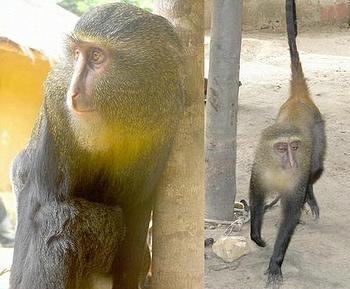
KINSHASA, Democratic Republic of Congo, September 12, 2012 (ENS) – Scientists have discovered a new species of monkey in a remote forested part of the Democratic Republic of Congo, only the second new species of monkey to be found in Africa in the past 28 years.
Known to local residents and hunters as Lesula, the monkey has been formally named Cercopithecus Lomamiensis. The new species is a member of the tribe Cercopithecini, commonly known as guenons.

It was named for its habitat in the Lomami forest basin. The Lesula is believed to live only within 17,000 square kilometers (6,500 square miles) of mature evergreen forests in the central DCR, between the middle Lomami and upper Tshuapa rivers.
The discovery was made public today in a paper in the open-access journal “Plos One.”
The first Lesula found was a young captive female seen in 2007 in a school director’s compound in the town of Opala. At first, the captive Lesula appeared to the scientists as similar to the owl faced monkey, but its coloring was unlike that of any other known species.
Over the next three years, the study authors, conservation biologists John and Terese Hart of the Lukuru Wildlife Research Foundation in Kinshasa, and their team, located and observed more Lesula in the wild and in captive situations.
“This was a totally unexpected find, and we knew we had something unusual and possibly unknown when we first saw the animal. But it was not until we had the genetic and morphological analyses of our collaborating team that we knew we really had a new species,” said the Harts, who are curatorial affiliates of Yale’s Peabody Museum of Natural History.
The species appears to have escaped previous scientific notice because of its remote habitat, until recently unexplored by professional biologists.

“Major discoveries like this are still possible, mainly thanks to dedicated field biologists like the Harts,” said Eric Sargis, professor of anthropology at Yale and a co-author of the paper.
“And if we’re finding new species of primates, then who knows how many new species of small mammals or lizards or insects, just to name a few, might be out there,” said Sargis. “There’s certainly a lot of undiscovered biodiversity in this region.”
After their first coincidental encounter with the captive Lesula, the Harts and their research team observed it in the wild, documented its behavior and ecology, and conclusively determined its uniqueness through genetic and anatomical studies.
These studies were conducted at the Peabody by Sargis and co-author Chris Gilbert, then a post-doctoral fellow at the Yale Institute for Biospheric Studies and now a professor at Hunter College-CUNY.
Other authors of the paper are Kate Detwiler of Florida Atlantic University; Andrew Burrell and Anthony Tosi of New York University; James Fuller of Columbia University; Maurice Emetshu of the Lukuru Wildlife Research Foundation; and Ashley Vosper of the Centre de Formation et Conservation Forestière.

“Discoveries of new African primate species are rare but significant events that clarify taxonomic and evolutionary relationships and highlight important regions of biodiversity for conservation,” the authors write in their paper.
In their paper, researchers describe the Lesula and its sister species, Cercopithecus hamlyni, as “shy, quiet and generally occur[ing] in small groups.”
C. hamlyni may be closely related but is separate and distinct from the Lesula. The scientists write, “morphological and molecular data confirm that C. lomamiensis is distinct from its nearest congener, C. hamlyni, from which it is separated geographically by both the Congo (Lualaba) and the Lomami Rivers.”
Seven specimens of C. lomamiensis and eight specimens of C. hamlyni were used for analyses and descriptions.
Specimens collected in the field included freshly killed animals acquired from local hunters, animals killed by leopards or crowned eagles, and one skin snip from a monkey captured locally and kept as a captive in a village near the species’ range.

The typical Lesula has a naked face and muzzle and a mane of long, grizzled blond hairs. Some have a cream-colored vertical nose stripe. The monkey appears to eat fruits and vegetation primarily, and to live both on the ground and in trees.
At least three other primates are found only in this region, according to the researchers – the Lomami River red colobus, the Lomami River blue monkey, and the Kasuku River Wolf’s monkey.
Like all of Congo’s remaining large mammals, these species are threatened by uncontrolled commercial bush meat hunting and habitat loss.
“The challenge now is to make the Lesula an iconic species that carries the message for conservation for all of Congo’s endangered fauna,” said John Hart. “Species with small ranges like the Lesula can move from vulnerable to seriously endangered over the course of just a few years.”
The research was supported by the Arcus Foundation, the U.S. Fish and Wildlife Service, a grant from Edith McBean, Abraham Foundation, Margot Marsh Biodiversity Foundation Grant, and the Yale Institute for Biospheric Studies.
Copyright Environment News Service (ENS) 2012. All rights reserved.
